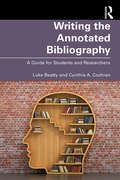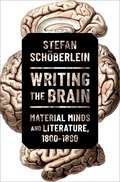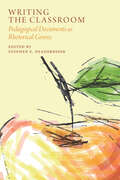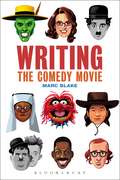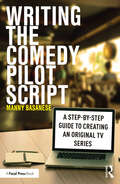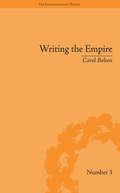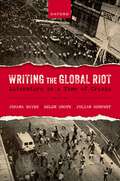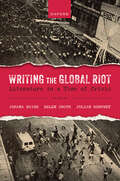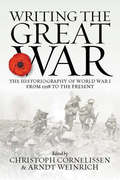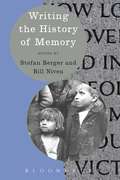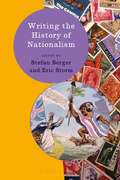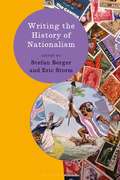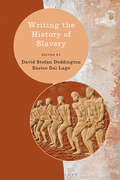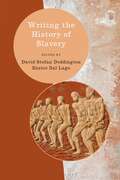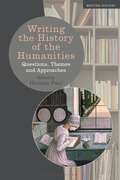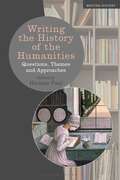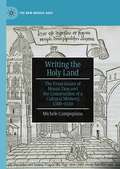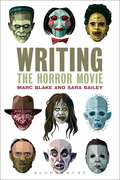- Table View
- List View
Writing the Annotated Bibliography: A Guide for Students & Researchers
by Luke Beatty Cynthia A CochranThis comprehensive and practical guide covers the elements, style, and use of annotated bibliographies in the research and writing process for any discipline; key disciplinary conventions; and tips for working with digital sources. Written jointly by a library director and a writing center director, this book is packed with examples of individual bibliography entries and full bibliography formats for a wide range of academic needs. Online resources include sample bibliographies, relevant web links, printable versions of checklists and figures, and further resources for instructors and researchers. Writing the Annotated Bibliography is an essential resource for first-year and advanced composition classes, courses in writing across the disciplines, graduate programs, library science instruction programs, and academic libraries at the secondary level and beyond. It is suitable for both undergraduate and graduate students and for researchers at all levels.
Writing the Annotated Bibliography: A Guide for Students & Researchers
by Luke Beatty Cynthia A CochranThis comprehensive and practical guide covers the elements, style, and use of annotated bibliographies in the research and writing process for any discipline; key disciplinary conventions; and tips for working with digital sources. Written jointly by a library director and a writing center director, this book is packed with examples of individual bibliography entries and full bibliography formats for a wide range of academic needs. Online resources include sample bibliographies, relevant web links, printable versions of checklists and figures, and further resources for instructors and researchers. Writing the Annotated Bibliography is an essential resource for first-year and advanced composition classes, courses in writing across the disciplines, graduate programs, library science instruction programs, and academic libraries at the secondary level and beyond. It is suitable for both undergraduate and graduate students and for researchers at all levels.
Writing the Brain: Material Minds and Literature, 1800-1880
by Stefan SchöberleinIn the nineteenth century, American and British culture experienced an explosion of interest in writings about the brain. The years between 1800 and 1880 are often described as the emergence of modern neuroscience, with new areas of the brain being discovered and named. Naming was quickly followed by a drive to hypothesize functioning, a process that suggested thinking itself may be a mere physiological act. In Writing the Brain, Stefan Schöberlein tracks how literature encountered such novel, scientific theories of cognition-and how it, in turn, shaped scientific thinking. Before the era of modern psychology, a heterogeneous group of alienists, self-help gurus, and anatomists proposed that the structure of the brain could be used to explain how the mind worked. Suddenly, nineteenth-century readers and writers had to contend with the idea that qualities once ascribed to disembodied souls may arise from a mere lump of cranial matter. In a period when scientists and literary writers frequently published in the same periodicals, the ensuing debate over the material mind was a public one. Writing the Brain demonstrates, by examining several canonical works and textual rediscoveries, that these exchanges not only influenced how poets and novelists fictionalized the mind but also how scientists thought and talked about their discoveries. From George Combe to Charles Dickens, from Emily Dickinson to Pliny Earle, from Benjamin Rush to Alfred Tennyson, 1800s debated what it means to have or, rather, be a brain.
Writing the Brain: Material Minds and Literature, 1800-1880
by Stefan SchöberleinIn the nineteenth century, American and British culture experienced an explosion of interest in writings about the brain. The years between 1800 and 1880 are often described as the emergence of modern neuroscience, with new areas of the brain being discovered and named. Naming was quickly followed by a drive to hypothesize functioning, a process that suggested thinking itself may be a mere physiological act. In Writing the Brain, Stefan Schöberlein tracks how literature encountered such novel, scientific theories of cognition-and how it, in turn, shaped scientific thinking. Before the era of modern psychology, a heterogeneous group of alienists, self-help gurus, and anatomists proposed that the structure of the brain could be used to explain how the mind worked. Suddenly, nineteenth-century readers and writers had to contend with the idea that qualities once ascribed to disembodied souls may arise from a mere lump of cranial matter. In a period when scientists and literary writers frequently published in the same periodicals, the ensuing debate over the material mind was a public one. Writing the Brain demonstrates, by examining several canonical works and textual rediscoveries, that these exchanges not only influenced how poets and novelists fictionalized the mind but also how scientists thought and talked about their discoveries. From George Combe to Charles Dickens, from Emily Dickinson to Pliny Earle, from Benjamin Rush to Alfred Tennyson, 1800s debated what it means to have or, rather, be a brain.
Writing the Classroom: Pedagogical Documents as Rhetorical Genres
Writing the Classroom explores how faculty compose and use pedagogical documents to establish classroom expectations and teaching practices, as well as to articulate the professional identities they perform both inside and outside the classroom. The contributors to this unique collection employ a wide range of methodological frameworks to demonstrate how pedagogical genres—even ones as seemingly straightforward as the class syllabus—have lives extending well beyond the classroom as they become part of how college teachers represent their own academic identities, advocate for pedagogical values, and negotiate the many external forces that influence the act of teaching. Writing the Classroom shines a light on genres that are often treated as two-dimensional, with purely functional purposes, arguing instead that genres like assignment prompts, course proposals, teaching statements, and policy documents play a fundamental role in constructing the classroom and the broader pedagogical enterprise within academia. Writing the Classroom calls on experienced teachers and faculty administrators to critically consider their own engagement with pedagogical genres and offers graduate students and newer faculty insight into the genres that they may only now be learning to inhabit as they seek to establish their personal teacherly identities. It showcases the rhetorical complexity of the genres written in the service of pedagogy not only for students but also for the many other audiences within academia that have a role in shaping the experience of teaching. Contributors: Michael Albright, Lora Arduser, Lesley Erin Bartlett, Logan Bearden, Lindsay Clark, Dana Comi, Zack K. De Piero, Matt Dowell, Amy Ferdinandt Stolley, Mark A. Hannah, Megan Knight, Laura R. Micciche, Cindy Mooty, Dustin Morris, Kate Navickas, Kate Nesbit, Jim Nugent, Lori A. Ostergaard, Cynthia Pengilly, Jessica Rivera-Mueller, Christina Saidy, Megan Schoen, Virginia Schwarz, Christopher Toth
Writing the Comedy Movie
by Marc BlakeIt is often suggested that there are 'secrets' to comedy or that it is 'lightning in a bottle', but the craft of comedy writing can be taught. While comedic tastes change, over time and from person to person, the core underpinning still depends on the comedic geniuses that have paved the way. Great comedy is built upon a strong foundation. In Writing the Comedy Movie, Marc Blake lays out – in an entertainingly readable style – the nuts and bolts of comedy screenwriting. His objective is to clarify the 'rules' of comedy: to contextualize comedy staples such as the double act, slapstick, gross-out, rom com, screwball, satire and parody and to introduce new ones such as the bromance or stoner comedy. He explains the underlying principles of comedy and comedy writing for the screen, along with providing analysis of leading examples of each subgenre.
Writing the Comedy Movie
by Marc BlakeIt is often suggested that there are 'secrets' to comedy or that it is 'lightning in a bottle', but the craft of comedy writing can be taught. While comedic tastes change, over time and from person to person, the core underpinning still depends on the comedic geniuses that have paved the way. Great comedy is built upon a strong foundation. In Writing the Comedy Movie, Marc Blake lays out – in an entertainingly readable style – the nuts and bolts of comedy screenwriting. His objective is to clarify the 'rules' of comedy: to contextualize comedy staples such as the double act, slapstick, gross-out, rom com, screwball, satire and parody and to introduce new ones such as the bromance or stoner comedy. He explains the underlying principles of comedy and comedy writing for the screen, along with providing analysis of leading examples of each subgenre.
Writing the Comedy Pilot Script: A Step-by-Step Guide to Creating an Original TV Series
by Manny BasaneseNavigating through the challenging process of writing a comedy pilot, this book will help screenwriters to create an original script for television. Practical and accessible, the book presents a step-by-step guide focusing on the key elements of the process. Incorporating both the history of TV comedy as well as its current evolving state in this age of the dramedy and an ever-increasing variety of broadcast and streaming platforms, the book will serve as a guide for the fledgling sitcom scribe. Author Manny Basanese breaks down the comedy pilot writing process from what may be perceived as an overwhelming, time-consuming mission into a series of much more manageable, smaller steps (from logline to outline to 1st, 2nd and polished draft). Utilizing his experience in Hollywood’s sitcom trenches, the author offers real-world advice on such topics as building the comedy pilot "world," creating memorable comic characters, sound sitcom structure, and the importance of crafting an emotional through line in a comedy pilot. Finally, there is also practical career guidance for marketing this just-completed script and breaking into the industry with advice on various topics such as the value of networking as well as gaining representation in the competitive Hollywood jungle. It is ideal for students of screenwriting and aspiring comedy screenwriters.
Writing the Comedy Pilot Script: A Step-by-Step Guide to Creating an Original TV Series
by Manny BasaneseNavigating through the challenging process of writing a comedy pilot, this book will help screenwriters to create an original script for television. Practical and accessible, the book presents a step-by-step guide focusing on the key elements of the process. Incorporating both the history of TV comedy as well as its current evolving state in this age of the dramedy and an ever-increasing variety of broadcast and streaming platforms, the book will serve as a guide for the fledgling sitcom scribe. Author Manny Basanese breaks down the comedy pilot writing process from what may be perceived as an overwhelming, time-consuming mission into a series of much more manageable, smaller steps (from logline to outline to 1st, 2nd and polished draft). Utilizing his experience in Hollywood’s sitcom trenches, the author offers real-world advice on such topics as building the comedy pilot "world," creating memorable comic characters, sound sitcom structure, and the importance of crafting an emotional through line in a comedy pilot. Finally, there is also practical career guidance for marketing this just-completed script and breaking into the industry with advice on various topics such as the value of networking as well as gaining representation in the competitive Hollywood jungle. It is ideal for students of screenwriting and aspiring comedy screenwriters.
Writing the Empire: Robert Southey and Romantic Colonialism (The Enlightenment World)
by Carol BoltonExamines a range of Robert Southey's writing to explore the relationship between Romantic literature and colonial politics during the expansion of Britain's second empire. This study draws upon a range of interdisciplinary materials to consider the impact of his work upon nineteenth-century views of empire.
Writing the Empire: Robert Southey and Romantic Colonialism (The Enlightenment World #3)
by Carol BoltonExamines a range of Robert Southey's writing to explore the relationship between Romantic literature and colonial politics during the expansion of Britain's second empire. This study draws upon a range of interdisciplinary materials to consider the impact of his work upon nineteenth-century views of empire.
Writing the Global Riot: Literature in a Time of Crisis
by Jumana Bayeh Helen Groth Julian MurphetThe history of the modern riot parallels the development of the modern novel and the modern lyric. Yet there has been no sustained attempt to trace or theorize the various ways writers over time and in different contexts have shaped cultural perceptions of the riot as a distinctive form of political and social expression. Through a focus on questions of voice, massing, and mediation, this collection is the first cross-cultural study of the interrelatedness of a prevalent mode of political and economic protest and the variable styles of writing that riots inspired. This volume will provide historical depth and cultural nuance, as well as examine more recent theoretical attempts to understand the resurgence of rioting in a time of unprecedented global uncertainty. One of the key contentions of this collection is that literature has done more than merely record riotous practices. Rather literature has, in variable ways, used them as raw material to stimulate and accelerate its own formal development and critical responsiveness. For some writers this has manifested in a move away from classical norms of propriety and accord, and toward a more openly contingent, chaotic, and unpredictable scenography and cast of dramatis personae, while others have moved towards narrative realism or, more recently, digital media platforms to manifest the crises that riots unleash. Keenly attuned to these formal variations, the essays in this collection analyse literature's fraught dialogue with the histories of violence that are bound up in the riot as an inherently volatile form of collective action.
Writing the Global Riot: Literature in a Time of Crisis
by Jumana Bayeh Helen Groth Julian MurphetThe history of the modern riot parallels the development of the modern novel and the modern lyric. Yet there has been no sustained attempt to trace or theorize the various ways writers over time and in different contexts have shaped cultural perceptions of the riot as a distinctive form of political and social expression. Through a focus on questions of voice, massing, and mediation, this collection is the first cross-cultural study of the interrelatedness of a prevalent mode of political and economic protest and the variable styles of writing that riots inspired. This volume will provide historical depth and cultural nuance, as well as examine more recent theoretical attempts to understand the resurgence of rioting in a time of unprecedented global uncertainty. One of the key contentions of this collection is that literature has done more than merely record riotous practices. Rather literature has, in variable ways, used them as raw material to stimulate and accelerate its own formal development and critical responsiveness. For some writers this has manifested in a move away from classical norms of propriety and accord, and toward a more openly contingent, chaotic, and unpredictable scenography and cast of dramatis personae, while others have moved towards narrative realism or, more recently, digital media platforms to manifest the crises that riots unleash. Keenly attuned to these formal variations, the essays in this collection analyse literature's fraught dialogue with the histories of violence that are bound up in the riot as an inherently volatile form of collective action.
Writing the Great War: The Historiography of World War I from 1918 to the Present
by Christoph Cornelissen and Arndt WeinrichFrom the Treaty of Versailles to the 2018 centenary and beyond, the history of the First World War has been continually written and rewritten, studied and contested, producing a rich historiography shaped by the social and cultural circumstances of its creation. Writing the Great War provides a groundbreaking survey of this vast body of work, assembling contributions on a variety of national and regional historiographies from some of the most prominent scholars in the field. By analyzing perceptions of the war in contexts ranging from Nazi Germany to India’s struggle for independence, this is an illuminating collective study of the complex interplay of memory and history.
Writing the Great War: The Historiography of World War I from 1918 to the Present
by Christoph Cornelissen Arndt WeinrichFrom the Treaty of Versailles to the 2018 centenary and beyond, the history of the First World War has been continually written and rewritten, studied and contested, producing a rich historiography shaped by the social and cultural circumstances of its creation. Writing the Great War provides a groundbreaking survey of this vast body of work, assembling contributions on a variety of national and regional historiographies from some of the most prominent scholars in the field. By analyzing perceptions of the war in contexts ranging from Nazi Germany to India’s struggle for independence, this is an illuminating collective study of the complex interplay of memory and history.
Writing the History of Memory (Writing History)
by Stefan Berger Bill NivenHow objective are our history books? This addition to the Writing History series examines the critical role that memory plays in the writing of history.This book includes:- Essays from an international team of historians, bringing together analysis of forms of public history such as museums, exhibitions, memorials and speeches- Coverage of the ancient world to the present, on topics such as oral history and generational and collective memory- Two key case studies on Holocaust memorialisation and the memory of Communism
Writing the History of Memory (Writing History)
by Stefan Berger Bill NivenHow objective are our history books? This addition to the Writing History series examines the critical role that memory plays in the writing of history.This book includes:- Essays from an international team of historians, bringing together analysis of forms of public history such as museums, exhibitions, memorials and speeches- Coverage of the ancient world to the present, on topics such as oral history and generational and collective memory- Two key case studies on Holocaust memorialisation and the memory of Communism
Writing the History of Nationalism (Writing History)
by Stefan Berger Eric StormWhat is nationalism and how can we study it from a historical perspective? Writing the History of Nationalism answers this question by examining eleven historical approaches to nationalism studies in theory and practice.An impressive cast of contributors cover the history of nationalism from a wide range of thematic approaches, from traditional modernist and Marxist perspectives to more recent debates around gender. postcolonialism and the global turn in history writing.This book is essential reading for undergraduate students of history, politics and sociology wanting to understand the complex yet fascinating history of nationalism.
Writing the History of Nationalism (Writing History)
by Stefan Berger Eric StormWhat is nationalism and how can we study it from a historical perspective? Writing the History of Nationalism answers this question by examining eleven historical approaches to nationalism studies in theory and practice.An impressive cast of contributors cover the history of nationalism from a wide range of thematic approaches, from traditional modernist and Marxist perspectives to more recent debates around gender. postcolonialism and the global turn in history writing.This book is essential reading for undergraduate students of history, politics and sociology wanting to understand the complex yet fascinating history of nationalism.
Writing the History of Slavery (Writing History)
by Edited by David Stefan Doddington Enrico Dal LagoExploring the major historiographical, theoretical, and methodological approaches that have shaped studies on slavery, this addition to the Writing History series highlights the varied ways that historians have approached the fluid and complex systems of human bondage, domination, and exploitation that have developed in societies across the world. The first part examines more recent attempts to place slavery in a global context, touching on contexts such as religion, empire, and capitalism. In its second part, the book looks closely at the key themes and methods that emerge as historians reckon with the dynamics of historical slavery. These range from politics, economics and quantitative analyses, to race and gender, to pyschohistory, history from below, and many more. Throughout, examples of slavery and its impact are considered across time and place: in Ancient Greece and Rome, Medieval Europe, colonial Asia, Africa, and the Americas, and trades throughout the Atlantic and Indian Oceans. Also taken into account are thinkers from Antiquity to the 20th century and the impact their ideas have had on the subject and the debates that follow. This book is essential reading for students and scholars at all levels who are interested in not only the history of slavery but in how that history has come to be written and how its debates have been framed across civilizations.
Writing the History of Slavery (Writing History)
Exploring the major historiographical, theoretical, and methodological approaches that have shaped studies on slavery, this addition to the Writing History series highlights the varied ways that historians have approached the fluid and complex systems of human bondage, domination, and exploitation that have developed in societies across the world. The first part examines more recent attempts to place slavery in a global context, touching on contexts such as religion, empire, and capitalism. In its second part, the book looks closely at the key themes and methods that emerge as historians reckon with the dynamics of historical slavery. These range from politics, economics and quantitative analyses, to race and gender, to pyschohistory, history from below, and many more. Throughout, examples of slavery and its impact are considered across time and place: in Ancient Greece and Rome, Medieval Europe, colonial Asia, Africa, and the Americas, and trades throughout the Atlantic and Indian Oceans. Also taken into account are thinkers from Antiquity to the 20th century and the impact their ideas have had on the subject and the debates that follow. This book is essential reading for students and scholars at all levels who are interested in not only the history of slavery but in how that history has come to be written and how its debates have been framed across civilizations.
Writing the History of the Humanities: Questions, Themes, and Approaches (Writing History)
by Herman PaulWhat are the humanities? As the cluster of disciplines historically grouped together as “humanities” has grown and diversified to include media studies and digital studies alongside philosophy, art history and musicology to name a few, the need to clearly define the field is pertinent. Herman Paul leads a stellar line-up of esteemed and early-career scholars to provide an overview of the themes, questions and methods that are central to current research on the history of the nineteenth- and twentieth-century humanities. This exciting addition to the successful Writing History series will draw from a wide range of case-studies from diverse fields, as classical philology, art history, and Biblical studies, to provide a state-of-the-art overview of the field.In doing so, this ground-breaking book challenges the rigid distinctions between disciplines and show the variety of prisms through which historians of the humanities study the past.
Writing the History of the Humanities: Questions, Themes, and Approaches (Writing History)
by Herman PaulWhat are the humanities? As the cluster of disciplines historically grouped together as “humanities” has grown and diversified to include media studies and digital studies alongside philosophy, art history and musicology to name a few, the need to clearly define the field is pertinent. Herman Paul leads a stellar line-up of esteemed and early-career scholars to provide an overview of the themes, questions and methods that are central to current research on the history of the nineteenth- and twentieth-century humanities. This exciting addition to the successful Writing History series will draw from a wide range of case-studies from diverse fields, as classical philology, art history, and Biblical studies, to provide a state-of-the-art overview of the field.In doing so, this ground-breaking book challenges the rigid distinctions between disciplines and show the variety of prisms through which historians of the humanities study the past.
Writing the Holy Land: The Franciscans of Mount Zion and the Construction of a Cultural Memory, 1300–1550 (The New Middle Ages)
by Michele CampopianoThe book shows how the Franciscans in Jerusalem in the fourteenth to sixteenth centuries wrote works which standardized the cultural memory of the Holy Land. The experience of the late medieval Holy Land was deeply connected to the presence of the Franciscans of the Convent of Mount Zion in Jerusalem, who welcomed and guided pilgrims. This book analyses this construction of a shared memory based on the continuous availability of these texts in the Franciscan library of Mount Zion, where they were copied and adapted to respond to new historical contexts. This book shows how the Franciscans developed a representation of the Holy Land by elaborating on its history and describing its religious groups and the geography of the region. This representation circulated among pilgrims and influenced how contemporaries imagined the Holy Land
Writing the Horror Movie
by Marc Blake Sara BaileyTales of horror have always been with us, from Biblical times to the Gothic novel to successful modern day authors and screenwriters. Though the genre is often maligned, it is huge in popularity and its resilience is undeniable. Marc Blake and Sara Bailey offer a detailed analysis of the horror genre, including its subgenres, tropes and the specific requirements of the horror screenplay.Tracing the development of the horror film from its beginnings in German Expressionism, the authors engage in a readable style that will appeal to anyone with a genuine interest in the form and the mechanics of the genre. This book examines the success of Universal Studio's franchises of the '30s to the Serial Killer, the Slasher film, Asian Horror, the Supernatural, Horror Vérité and current developments in the field, including 3D and remakes. It also includes step-by-step writing exercises, annotated extracts from horror screenplays and interviews with seasoned writers/directors/ producers discussing budget restrictions, screenplay form and formulas and how screenplays work during shooting.
